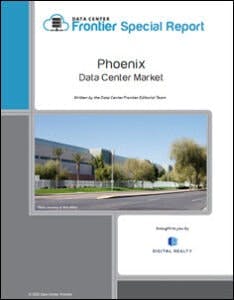Last week we launched a special report series on the Phoenix data center market. This week we’ll look at some of the key trends driving data center demand in this growing market.
Get the full report.
Demand for the Phoenix market continues to grow as organizations seek to exit more expensive markets and leverage Phoenix as a primary or disaster recovery region. When compared to other major U.S. data center markets, Phoenix is very competitive as it relates to colocation rates, power cost, and tax incentive opportunities.
These market attributes enable Phoenix to compete for data center requirements, with the largest deals coming from hyperscale deployments. Other companies consistently searching the Phoenix market include those in the e-commerce, financial, insurance, healthcare, and technology industries.
A Hot Startup Market
With its lower corporate income taxes, a lower regulatory burden, and cheaper office rentals, this city is proving to be the next tech stronghold in the US.
Phoenix is fertile ground for startups. Once seen as an area with limited investment dollars, the metro secured more than $1.2 billion in venture capital funding from 2015 to 2020.
Labor costs can be a major expense for growing businesses, but Phoenix has some of the most affordable employees, whose annual salary ($51,851) is 18% less than the studied city average ($63,363). Such low operation costs allow funding to last longer, giving businesses more time to get off the ground.
Phoenix ranks No. 2 among best cities to launch a startup, according to Time2play.
In California, the prospect of higher future utility bills, along with PG&E’s imposition of rolling service outages during periods of heightened wildfire risk, has customers looking beyond its borders for their West Coast data center workloads.
Exiting California
Phoenix continues to benefit from organizations exiting the California market. With reduced latency from Arizona into California, proximity becomes less of an issue for organizations that are in Phoenix wanting to reach the California market. Further, challenges with pricing, wildfires, and regulations has forced many organizations to migrate into other nearby markets.
For example, the California market has been roiled by the troubles of utility PG&E, which filed for bankruptcy protection in 2019 due to wildfire-related liabilities. The prospect of higher future utility bills, along with PG&E’s imposition of rolling service outages during periods of heightened wildfire risk, has customers looking beyond California’s borders for their West Coast data center workloads.
Phoenix is hardly alone as a destination for data center customers migrating out of California, as Las Vegas, Reno, Salt Lake City and the Pacific Northwest are other options. Some market watchers say firms migrating from Southern California typically look to Phoenix and Las Vegas as options, while customers from the Bay Area are more likely to consider the Pacific Northwest.
Download the full report, Phoenix Data Center Market, courtesy of Digital Realty, to learn more about what’s driving demand in this competitive data center market. In our next article, we’ll look at trends in data center supply. Catch up on the previous article here.



